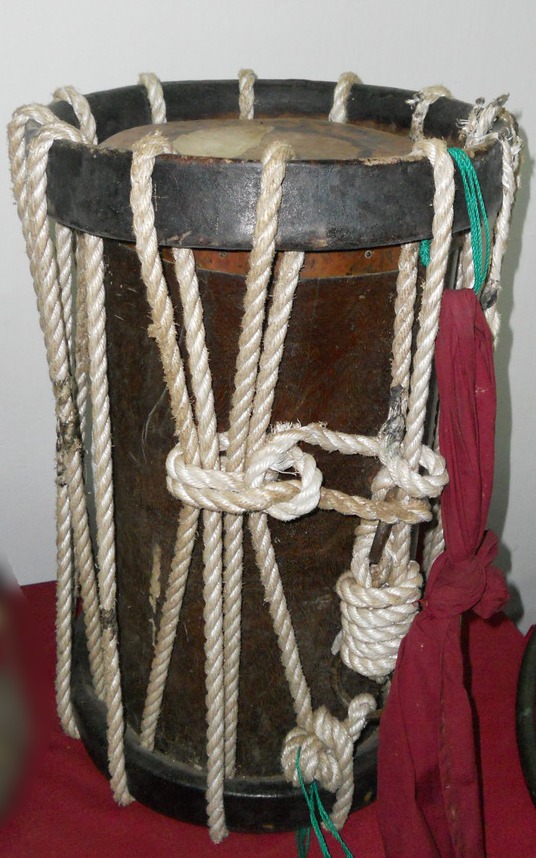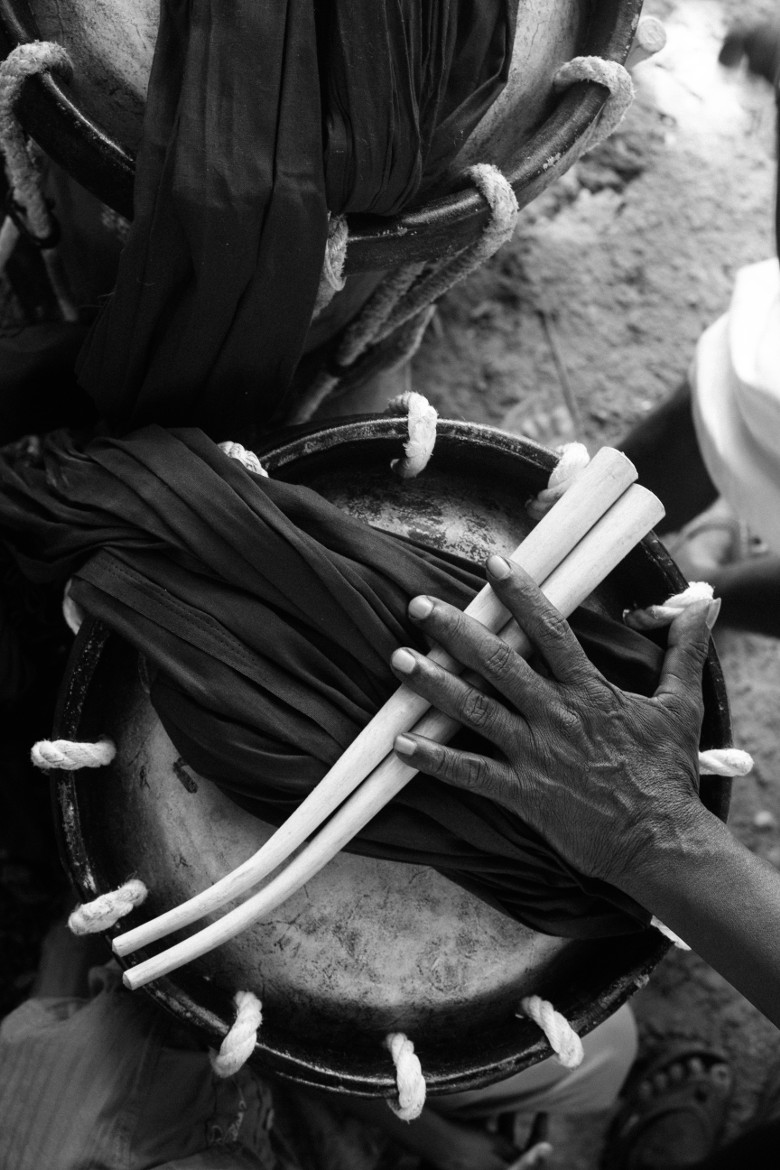|
Valamthala
Veekku chenda (വീക് ചെണ്ട) or "Acchan chenda" (അച്ഛൻ ചെണ്ട) is a type of Chenda or drum used to keep the "thalam" or the basic rhythm while playing the Chenda. The "Chenda Vattam" of the "Veekku Chenda" is always the "Valam Thala" or the "Right Head" which is made of multiple layer of skin to produce a bass sound. The meaning of "Veekku" in Malayalam language is "beating hard". The artist produce sound on "Veekku Chenda" by hitting the drum using a stick without twisting or rolling his wrist. The Chenda is a cylindrical percussion instrument used widely in the state of Kerala, and Tulu Nadu of Karnataka State in India. In Tulu Nadu it is known as ''chande''. It has a length of two feet and a diameter of one foot. Both ends are covered (usually with animal's skin) with the "Chenda Vattam". The animal skin is usually of a cow ( Heifer), in a traditional Chenda other skins are not used (skin of bull, ox etc. are not used), to have a quality ... [...More Info...] [...Related Items...] OR: [Wikipedia] [Google] [Baidu] |
Chenda Melam
The Chenda (, ) is a cylindrical percussion instrument originating in the state of Kerala and widely used in Tulu Nadu of Karnataka in India. In Tulu Nadu (Coastal Karnataka), it is known as ''chende''. The instrument is strongly associated with the cultural identity of both Kerala and Tulu Nadu. Traditionally, it is used by the Malayar ethnic groups in Kerala. According to their mythology, Lord Shiva blessed them with both the chenda and matravadham, which are considered synonymous in their mantravadha tradition, where sound plays a central role. This instrument is famous for its loud and rigid sound. A Chenda has two sides, the left side called " Edamthala" (ഇടം തല)(Left Head) and the right side "Valamthala" (വലം തല)(Right Head). The "Edamthala" is made of only one/two layer of cow skin and the "Valamthala" will have a five/seven layer skin, so as to have a bass sound. The skin are dried in the shade and fastened on wooden rings (Chenda Vattam, ച� ... [...More Info...] [...Related Items...] OR: [Wikipedia] [Google] [Baidu] |
Panchari Melam
Panchari Melam is a percussion ensemble, performed during Temple Festivals of Kerala, temple festivals in Kerala, India. Panchari Melam (or simply panchari), is one of the major forms of Chenda Melam (ethnic drum ensemble), and is the best-known and most popular in the ''kshetram vadyam'' (temple percussion) genre. Panchari Melam, comprising instruments like Chenda, Ilathalam, Kombu (instrument), Kombu and Kuzhal, is performed during many temple festivals in central Kerala, where it is presented in arguably the most classical manner. Panchari is also traditionally performed, albeit with a touch of subtle regional difference, in north Kerala (Malabar) and south-central Kerala (Kochi). Of late, its charm has led to its performance even in temples in Kerala's deep south. Panchari is a six-beat thaalam (tala (music), taal) with equivalents like Roopakam in south Indian Carnatic music and Daadra in the northern Hindustani classical. Another Chenda Melam which comes close to Panchar ... [...More Info...] [...Related Items...] OR: [Wikipedia] [Google] [Baidu] |
Drums
The drum is a member of the percussion instrument, percussion group of musical instruments. In the Hornbostel–Sachs classification system, it is a membranophones, membranophone. Drums consist of at least one Acoustic membrane, membrane, called a drumhead or drum skin, that is stretched over a shell and struck, either directly with the player's hands, or with a percussion mallet, to produce sound. There is usually a resonant head on the underside of the drum. Other techniques have been used to cause drums to make sound, such as the thumb roll. Drums are the world's oldest and most ubiquitous musical instruments, and the basic design has remained virtually unchanged for thousands of years. Drums may be played individually, with the player using a single drum, and some drums such as the djembe are almost always played in this way. Others are normally played in a set of two or more, all played by one player, such as bongo drums and timpani. A number of different drums together ... [...More Info...] [...Related Items...] OR: [Wikipedia] [Google] [Baidu] |
Indian Musical Instruments
Musical instruments of the Indian subcontinent can be broadly classified according to the Hornbostel–Sachs system into four categories: chordophones (string instruments), aerophones (wind instruments), membranophones (drums) and idiophones (non-drum percussion instruments). Chordophones Plucked string instrument, Plucked strings Bowed strings • Chikara • Dhantara • Dilruba • Ektara violin • Esraj • Kamaicha • Kingri (string instrument) • Mayuri Vina or Taus • Onavillu • Behala (violin type) • Pena (musical instrument) • Pinaka vina • Pulluvan Veena - one stringed violin • Ravanahatha • Sarangi • Classical Sarangi • Sarinda • Tar Shehnai • Taus • Villu Paatu - arched bow instrument Other string instruments * Gethu or Jhallari – struck tanpura * Gubguba or Jamuku (khamak) * Pulluvan kutam * Santoor – Hammered dulcimer Aerophones Single reed *Pepa (musical instrument), Pepa *Pungi or Pungi, Been Double reed * Kuzhal * Mukhavina ... [...More Info...] [...Related Items...] OR: [Wikipedia] [Google] [Baidu] |
Carnatic Music Instruments
Carnatic may refer to: * Carnatic region, Southern India *Carnatic music, the classical music of Southern India *, the name of several ships *, a minesweeper of the Royal Indian Navy *, the name of several ships of the Royal Navy See also * Karnataka (other) *Kannada (other) Kannada is a language spoken predominantly by the people of Karnataka in India. Kannada may also refer to: * Kannada script, Indic script used to write the language ** Kannada (Unicode block) * Kannadigas or Kannada people, speakers of the langu ... * Canara (other) * Carnatic Hall, in Liverpool, England * Carnatic wars, in India during the 18th century {{disambiguation, ship ca:Carnàtic ... [...More Info...] [...Related Items...] OR: [Wikipedia] [Google] [Baidu] |
Kathakali
''Kathakali'' (International Alphabet of Sanskrit Transliteration, IAST: Kathakaḷi ) is a traditional form of Indian Classical Dance, and one of the most complex forms of Theatre of India, Indian theatre. It is a play of verses. These verses are called Kathakali literature or ''Aattakatha (performance), Attakatha''. Mostly played in the courts of kings and temple festivals. Hence it is known as suvarna art forms. This performance uses the ''navarasas'' from the Natya Shastra text, authored by sage Bharata. Makeup and costumes are unique and large. It represents one of Kerala's traditional theater artforms. It is native to the Malayalam-speaking state of Kerala and is almost entirely practiced by Malayali people. Kathakali is closely related to a more ancient theater artform of Kerala called ''Kutiyattam'' which is the only surviving specimen of the ancient Sanskrit theatre, thought to have originated around the beginning of the common era, and is officially recognized by UN ... [...More Info...] [...Related Items...] OR: [Wikipedia] [Google] [Baidu] |
Kanyarkali
Kanniyar Kali is a folk dance ritual performed in Temples of villages in Alathur and Chittur Taluk of Palakkad district, Palakkad district of Kerala in India. The event is usually a part of Vishu celebrations of the village and usually succeeds the Vela (Village Fair) and is usually performed during the months of April and May. It is an agricultural festival dance of Nair community. Kanniyar Kali, despite the name of the Virgin, does not have anything to do with the Kannaki cult. Kanniyar Kali is in no way connected with the Kaniyar community, a community of authentic astrologers of Kerala. The Dance The dance is performed at night and ends at dawn, and is conducted for four consecutive nights. In certain villages it is conducted only for three consecutive nights. The dances start every night with the men of the community gathering in the temples and performing a rhythmic circular dance called vattakali (vattakali literally means a circular dance). The vattakali is fol ... [...More Info...] [...Related Items...] OR: [Wikipedia] [Google] [Baidu] |
Pandi Melam
Pandi melam is a classical percussion concert or melam (ensemble) led by the ethnic Kerala instrument called the chenda and accompanied by ilathalam (cymbals), kuzhal and Kombu. A full-length Pandi, a melam based on a thaalam ( taal) with seven beats, lasts more than two-and-a-half hours, and is canonically performed outside temples. It has basically four stages, each of them with rhythmic cycles (thaalavattam) totalling 56, 28, 14 and seven respectively. The most celebrated Pandi Melam is staged inside a temple compound at the ''Vadakkunnathan'' shrine's precincts in the central Kerala town of Thrissur. For the last several years, Peruvanam Kuttan Marar is the lead conductor for this symphony of drums known as ''Elanjithara Melam''. Elsewhere, like in the pooram festivals of Aarattupuzha and Peruvanam near Thrissur and the rest of central and northern Kerala, it is performed outside temples. Another ensemble called Panchari Melam, which is similar to Pandi going by the k ... [...More Info...] [...Related Items...] OR: [Wikipedia] [Google] [Baidu] |
Thayambaka
Thayambaka or tayambaka is a type of solo chenda performance that developed in the south Indian state of Kerala, in which the main player at the centre improvises rhythmically on the beats of half-a-dozen or a few more chenda and ilathalam players around. Performance A thayambaka performance on the chenda has thus its focus on the stick-and-palm rolls produced on the itantala (treble) of the chenda, while the rhythm is laid by his fellow instrumentalists on the (bass) and (cymbals). Thayambaka, believed to have flourished during the feudal era, spans an average of 90 minutes. It begins at a slow pace before scaling on to a medium tempo and eventually culminating in high, frenzied speed. It has a skeletal pattern on which the performance progresses, but the main performer has the liberty to improvise and innovate to showcase his grip of rhythm, finesse of techniques and cerebral brilliance. In fact, thayambaka is one chenda concert that allows maximum individual freedom to t ... [...More Info...] [...Related Items...] OR: [Wikipedia] [Google] [Baidu] |
Panchavadyam
Panchavadyam (Malayalam: പഞ്ചവാദ്യം), literally meaning an orchestra of five instruments, is basically a temple art form that has evolved in Kerala. Of the five instruments, four — timila, maddalam, ilathalam and idakka — belong to the percussion category, while the fifth, kombu, is a wind instrument. Much like any chenda melam, panchavadyam is characterised by a pyramid-like rhythmic structure with a constantly increasing tempo coupled with a proportional decrease in the number of beats in cycles. However, in contrast to a chenda melam, panchavadyam uses different instruments (though ilathalam and kompu are common to both), is not related very closely to any temple ritual and, most importantly, permits much personal improvisation while filling up the rhythmic beats on the timila, maddalam and idakka. Panchavadyam bases itself on the seven-beat thripuda (also spelt thripuda) thaalam ( taal) but amusingly sticks to the pattern of the eight-beat chemp ... [...More Info...] [...Related Items...] OR: [Wikipedia] [Google] [Baidu] |





